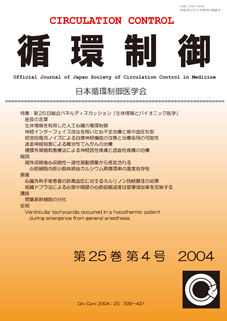All issues

Volume 25 (2004)
- Issue 4 Pages 378-
- Issue 3 Pages 261-
- Issue 2 Pages 158-
- Issue 1 Pages 37-
Volume 25, Issue 4
Displaying 1-3 of 3 articles from this issue
- |<
- <
- 1
- >
- >|
original articles
-
Kazuo Abe, Junko Oka, Hirotoshi Funatsu, Mugiho Takeuchi, Hirotsugu Fu ...2004 Volume 25 Issue 4 Pages 378-381
Published: 2004
Released on J-STAGE: February 07, 2005
JOURNAL FREE ACCESSTo evaluate the effects of milrinone on the pulmonary hypertension during cardiac surgery, 20 patients who showed pulmonary hypertension after anesthesia induction were studied. Pulmonary artery pressure(PAP), pulmonary vascular resistance(PVR) and hemodynamic parameters were measured before the milrinone infusion(0.5μg/kg/min), and 15min and 30min after the milrinone infusion. Six out of 20 patients were excluded because of decreases in systemic systolic blood pressure by more than 30%. In the other 14 patients, mean artery pressure(from 76±13 to 67±11mmHg), PAP (from 34±12 to 23±3mmHg), central venous pressure(from 12±5 to 8±6mmHg), and PVR(from 440±112 to 194±56 dyne/sec/cm-5) decreased significantly at 30 min after the milrinone infusion. Heart rate(from 79±23 to 98±20rate/min), cardiac output(from 3.4±1.6 to 4.9±2.6L/min) increased significantly at 30min after milrinone infusion. Oxygen saturation of mixed venous admixtures increased significantly at 15min after infusion (from 69±14 to 74±11%). These data suggest that milrinone may be a useful drug for the treatment of pulmonary hypertension during cardiac surgery.View full abstractDownload PDF (48K) -
Mika Hiki, Kozo Watanabe, Yoshinari Niimi, Shigeho Morita2004 Volume 25 Issue 4 Pages 382-385
Published: 2004
Released on J-STAGE: February 07, 2005
JOURNAL FREE ACCESSTissue Doppler imaging is a new technique that is based on color Doppler imaging principles and enables the quantification of intramural myocardial velocities by the detection of consecutive phase shifts of the ultrasound signal reflected from the contracting myocardium. We evaluated a correlation between myocardial velocity and the extent of wall motion thickening. In 31 patients undergoing coronary artery bypass grafting, the myocardial peak systolic velocity, peak diastolic velocity, and wall motion thickening were assessed in the basal and mid septum during surgery. A correlation was observed between myocardial peak systolic velocity and the extent of wall motion thickening. However, no significant correlation was observed between myocardial diastolic velocity and wall motion thickening. Myocardial systolic velocity which was derived from tissue Doppler imaging appears to be useful for quantification of regional left ventricular function.View full abstractDownload PDF (81K)
case reports
-
Nao Aoyama, Mutsuhito Kikura, Tomosue Takada, Shigeru Katoh, Shunsuke ...2004 Volume 25 Issue 4 Pages 393-396
Published: 2004
Released on J-STAGE: February 07, 2005
JOURNAL FREE ACCESSA 76-year-old man underwent trans-urethral resection of bladder tumor and laparoscopic total nephroureterectomy of the left renal pelvic and bladder tumor under general anesthesia combined with lumbar epidural anesthesia. Premature ventricular contractions and subsequent ventricular tachycardia occurred at emergence from anesthesia, when his rectal temperature was 33.5°C. Following cardiac massage and lidocaine administration, normal sinus rhythm was obtained. The arrhythmias were suspected to be mainly due to an increase of ventricular alpha- and beta-adrenoreceptor activation induced by perioperative hypothermia and mild hypercapnia.View full abstractDownload PDF (223K)
- |<
- <
- 1
- >
- >|